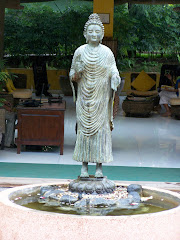
I'm trying to find my India in Canada. I still wear my bindi around and its pretty cute for Indian women to do a double take and smile a secret smile when they see a white girl in Edmonton donning the Indian tradition. I hope its not sacrilege or an insult, but I find it a good keepsake or souvenir from my wonderful trip. ***(See Bindi definition below)
Its also a reminder about not eating meat anymore, for some strange reason, the desire has left me. When I understand it in the terms of not causing suffering, it has more meaning. Anyone who has seen "Fast Food Nation" showing cows slaughtered at the meat packing plant, know what I mean. The worst was when Damian and I were in Cuba last winter. We witnessed 2 pigs being tortured, as they were hauled off on the back of bicycles, dehydrated and screaming like human babies, going to be roasted for a party.
Since being home, I have noticed a few other changes. Gratitude is very apparent in my mind. I cherish being with Damian once again, as well as stopping and hugging my kids as often as I can.
“God gave you a gift of 86,400 seconds today. Have you used one to say "thank you?"
~William Arthur Ward
Stopping to 'bless' my food and giving thanks before I eat is also important to me. Savouring the art of eating; tastes, smells, textures, and temperature. It reminds me of a dear yogi friend who captivated me with a simple meditation technique:
Holding an orange, feel it's texture, shape and skin. Feel the weight of the orange in your hand, as you stop and think about where the orange has been. The country, town or orchard it is conceived in, sprouting on a tree in the sunshine. Growing larger everyday amongst the wind, rain and leaves, ripening on the branch. Think about the person who picked the orange and packed it on a truck to travel the thousands of miles to get to you in that moment. Now in your hands, focus your intent as you peel the orange. Juice runs down your fingers, as you section the orange. Tasting the orange, it bursts in your mouth with sweet citrus tang. Savouring each chew on your tongue, aware of swallowing the flesh.
And so on! You can do it with anything, but the idea is to be thankful and enjoy!
...and thats what I am doing at home. Chelsie, my good friend and mother of 3 boys, said how envious she was of me having Lexi as a daughter. She said she longs for a daughter who wants to sit and have tea with her. I never realized how someone else who 'appears to have it all', longs for something that I take for granted. Sometimes it takes the absence of that beloved thing to make the heart grow fonder...
We can only be said to be alive in those moments when our hearts are conscious of our treasures. ~Thornton Wilder
***"Why Bindi? Bindi is derived from the Sanskrit word "Bindu" or a drop, it is supposed to signify the mystic third eye of a person and therefore, when properly marked, becomes the central point of the base of the creation itself. It is a symbol of auspiciousness, good fortune and festivity.
The very positioning of the bindi is significant. The area between the eyebrows is the seat of latent wisdom. This area is known as the "Agna" (6th chakra) meaning "command". It is said to control various levels of concentration attained through meditation. The central point of this area is the "Bindu" wherein all experience is gathered in total concentration. Tantric tradition has it that during meditation, the "kundalini" - the latent energy that lies at the base of the spine is awakened and rises to the point of sahasrara (7th chakra) situated in the head or brain. The central point, the bindu, becomes therefore a possible outlet for this potent energy. It is believed that the red kumkum lies between the eyebrows to retain energy in the human body.
Myths and Significance - The color red
The colour red is significant. Red represents Shakti (strength). Red, it is believed, symbolizes love. Some scholars have seen the red colour as a symbolism for blood. We are told that in ancient times, in Aryan society, a groom used to apply his blood, on his bride's forehead as recognition of wedlock.
It denotes the woman's married status in most of the North Indian communities but in South India it is a prerogative of all girls to wear a bindi.
The bindi, today is a fashion statement. Bindi, on the beloved's forehead is supposed to mesmerise her lover. The bindi still attracts a lot of attention, as it is the first thing that catches our eye. This little dot has always received a place of importance in Indian customs. The bindi carries with it a wealth of meaning and is an on-going link with a very ancient tradition and past." (Shaadi.com)


1 comment:
Hello,
You left a comment on my blog a while ago--Jeffslife. If you can believe it, I just now read it. That was like 4 months ago. Sorry, it took so long to respond.
You don't post on your blog very much. Why not? Also, is that a picture of yourself? If so, you are quite beautiful.
Anyway, thanks for reading my blog. Have a great day.
Jeff
Post a Comment